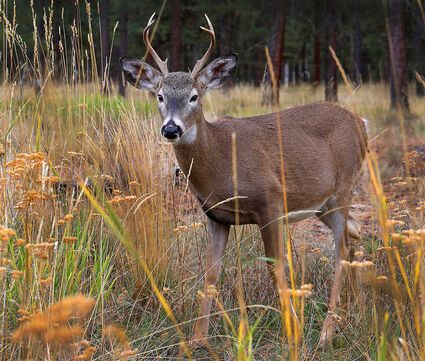Big game hunting season gets underway
October 27, 2022
General hunting season is underway in Montana, and cooler weather greeted hunters in the northwest corner of the state.
More than 1,700 hunters appeared at regional game check stations on Saturday and Sunday with mixed results. The overall number of hunters with harvested white-tailed deer and mule deer was slightly up while the number of elk was down compared to last year. The check station along U.S. Highway 93 near Olney saw the highest percentage of hunters with harvested game at 21 percent.
Montana's general deer and elk hunting season runs from Oct. 22-Nov. 27. Other hunting seasons underway include black bear (Sept. 15-Nov. 27), bighorn sheep (Sept. 15-Nov. 27), moose (Sept. 15-Nov. 27), mountain lion (fall season without dogs, Oct. 22-Nov. 27), mountain goat (Sept. 15-Nov. 27), turkey (Sept. 1-Jan. 1), and wolf (Sept. 15-March 15, 2023).
Check stations are open on weekends during general deer and elk hunting season from 10 a.m. to approximately 1.5 hours past sunset. The regional stations are located at U.S. Highway 2 West of Kalispell, Montana Highway 83 north of Swan Lake, Highway 200 west of Thompson Falls, and Highway 93 near Olney. Hunters must stop at any check station they encounter whether they harvested an animal or not. The counts at the stations represent a sampling of the harvest and do not represent the complete number of animals taken.
At the Thompson Falls check station just west of town, the number of hunters was down from the 2021 opening weekend, but the number of harvested animals was up. Juster 254 went through the check station last weekend, compared with 281 in 2021. Hunters reported harvesting 21 white-tailed deer (eight of those bucks), five mule deer and three elk. The number of hunters having a successful opening weekend was 11.45, up from 8.2% last year.

Northwest Montana (Region 1) Reminders
• Hunters should review the regulations for each hunting district they plan to hunt.
• Elk hunting is brow-tined bull only in Region 1 (northwest Montana) except in Hunting District 170, unless a hunter has an antlerless elk permit or a Permit to Hunt from a Vehicle (PTHFV). A brow-tined bull is defined as, "any elk having an antler or antlers with a visible point on the lower half of either main beam that is greater than or equal to four inches long."
• Hunters can harvest an either-sex white-tailed deer on their general deer license from Oct. 22-Oct. 28 in most Region 1 hunting districts. Youth ages 10-15 and hunters with a Permit to Hunt from a Vehicle (PTHFV) can still harvest either-sex whitetails throughout most of the region for the remainder of the season (check regulations for specifics). An "either-sex" deer is defined as, "a male or female animal of any age."
• Hunters who purchased the limited 199-20 either-sex white-tailed deer B license can only use that license within the Libby CWD Management Zone.
• Many private lands that were historically owned by corporate timber companies have changed ownership, and hunters should review the Block Management Program for Region 1 to view available public access opportunities and restrictions on private lands.
• Hunters should "Be Bear Aware" and properly store food and carcasses. Hunters should avoid hanging carcasses near houses or garages. Carcasses should be suspended at least 10 feet above the ground and 4 feet out from any upright support. Hunters are encouraged to carry bear spray and know how to use it. More food storage and safety information are available on the FWP website.
• The toll-free hotline for reporting wildlife poaching, property damage, and violations of Montana fish and game laws is in operation 24 hours a day. If you witness a fish and game violation, or property vandalism, you can report the crime by calling 1-800-TIP-MONT (1-800-847-6668); or report a violation online at fwp.mt.gov. Callers may remain anonymous and may be eligible for a cash reward.
Chronic Wasting Disease
Testing for chronic wasting disease (CWD) is voluntary throughout the state. FWP can assist hunters with sample collection and submission, or hunters can submit samples themselves.
For assistance in northwest Montana, hunters can bring their animal to the FWP office in Kalispell, Monday-Friday from 8 a.m. to 5 p.m. FWP staff will also assist with CWD sample collection at weekend game check stations when possible and safety allows, based on traffic at the station. Stopping at game check stations remains mandatory. FWP will cover the cost of testing hunter-harvested animals for CWD.
A CWD sampling station in Libby will operate Saturdays, Sundays, and Mondays, 10 a.m. to 1.5 hours past sunset at the Montana Department of Transportation shop on U.S. Highway 2 south of town. Hunters are not required to stop at the Libby CWD sampling station.
Hunters who want their animal sampled should leave 2 to 4 inches of the neck below the low jawbone and base of the skull to ensure lymph nodes are present and not inadvertently left with the carcass. Samples cannot be collected from frozen heads.
To help prevent the spread of CWD, all carcasses, including the head and spinal column, must be disposed of in a class II landfill after butchering and processing. Dumping carcasses is illegal, unethical and can spread diseases, including chronic wasting disease. This requirement applies to all deer, elk, and moose carcasses harvested by hunters or as vehicle-killed salvage.
Contact a Montana Fish, Wildlife & Parks regional office for more information. In northwest Montana, call (406) 752-5501.



Reader Comments(0)